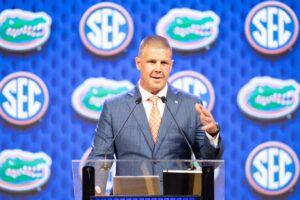Mountaineer fans often disclaim the importance of recruiting rankings and star designations. For the Mountaineers, however, the importance of recruiting under Dana Holgorsen is clear. Holgorsen has employed a multi-faceted focus on Power 5 transfers, graduate transfers, Junior College transfers, and traditional high school recruits to build a talent-rich roster. As a result, the Mountaineers’ football team currently develops more raw talent than at any point in its history.
Mountaineers’ Recruiting History
To be blunt, the Mountaineers have not had significant sustained recruiting success at any point since 2000, the first year for which reliable team recruiting rankings are available. The following chart shows the Mountaineers’ team recruiting ranking each year since 2000.
| Year | 2000 | 2001 | 2002 | 2003 | 2004 | 2005 | 2006 | 2007 | 2008 |
| Rank | 44 | 51 | 50 | 54 | 38 | 37 | 60 | 24 | 49 |
| 2009 | 2010 | 2011 | 2012 | 2013 | 2014 | 2015 | 2016 | 2017 | 2018 |
| 30* | 32 | 52 | 35 | 30 | 39 | 35 | 39 | 57 | 35 |
*247Sports included Geno Smith twice in the 2009 rankings. Eliminating the second inclusion of Smith yields a ranking of 30.
Since 2000, the Mountaineers’ average recruiting ranking was 41. Don Nehlen averaged a ranking of 48. Rich Rodriguez averaged a ranking of 45. Bill Stewart averaged a ranking of 38. Finally, Holgorsen averages a ranking of 39.
Digging Deeper into Retention
Retention under Coach Stewart
However, a deeper dig into the numbers tells a different tale. Stewart started with two solid classes. Isolating his top recruits to include players rated in the 247Sports composite rankings to .870 or greater (high 3-star and above) shows Stewart’s rankings were inflated.
| Year | 4-star+ recruits | Number retained | High 3-star recruits | Number retained |
| 2009 | 5 | 2 | 4 | 1 |
| 2010 | 5 | 3 | 1 | 0 |
| 2011 | 0 | 0 | 2 | 1 |
In total, Stewart only retained half of his 4-star recruits. Similarly, he retained less than 30% of his high 3-star recruits. Thus, Stewart retained only 41% of his top-rated recruits.
Retention under Coach Holgorsen
On the other hand, the same data for Dana Holgorsen’s first five classes evidences a much higher retention rate.
| Year | 4-star+ recruits | Number retained | High 3-star recruits | Number retained |
| 2012 | 1 | 0 | 4 | 3 |
| 2013 | 2 | 2 | 3 | 3 |
| 2014 | 2 | 3 | 0 | 1 |
| 2015 | 2 | 4 | 2 | 2 |
| 2016* | 2 | 3 | 2 | 2 |
*The 2017 and 2018 classes are omitted because long-term retention cannot yet be measured.
Between his 2012 and 2016 recruiting classes, Holgorsen retained 62% of his 4-star recruits and 83% of his high 3-star recruits. In total, Holgorsen retained 72% of his top-rated recruits. Nationally, programs average a retention rate just under 60%.
Based on these figures, Stewart underperformed in terms of retention against his peers by nearly 20%. On the other hand, Holgorsen outperformed his peers by over 10%. Thus, if we recalculate classes to factor in attrition rates versus average, Holgorsen’s average ranking increases while Stewart’s drops dramatically.
Digging Deeper into Power 5 Transfers
Based on available information, West Virginia did not have any highly-rated incoming Power 5 transfers to the program under Coach Stewart. Under Holgorsen, however, the Mountaineers have added a number of memorable Power 5 transfers. Rushel Shell was a 2012 5-star recruit. Kenny Bigelow and Kyle Bosch were 2013 blue chip recruits. Will Grier was a 4-star 2014 recruit. Jabril Robinson was a 3-star 2014 recruit. Jack Allison, Jovani Haskins, and T.J. Simmons were 4-star 2015 recruits. And VanDarius Cowan is a 4-star 2017 recruit.
By adding each of the above players to the respective classes under Holgorsen, the current annual class rankings improve as follows.
| Year | 2012 | 2013 | 2014 | 2015 | 2016 | 2017 | 2018 |
| Rank | 29 | 20 | 32 | 29 | 39 | 44 | 35 |
Departing from his predecessors, Holgorsen added a niche to his recruiting profile by playing heavily in the Power 5 transfer market. When factoring in the gains from this market, the average class at West Virginia under Holgorsen ranks 32nd. Add that to the bump he receives from having a higher-than-average retention rate of star players, and Holgorsen easily falls within the top 25 nationally.
Why It Matters
The Rankings Don’t Always Predict Success
Again, the average Mountaineer fan ignores recruiting rankings and predictions. After all, most programs overlooked mid-3-star recruits Pat White and Steve Slaton. In fact, Slaton was projected to sit behind 5-star recruit Jason Gwaltney. Not to mention, the Mountaineers achieved a number two ranking despite having only a couple top 25 recruiting classes.
These fans are not completely wrong. Recruiting rankings do not guarantee success. For example, Notre Dame finished with a top ten recruiting class in 11 of the last 19 seasons. However, they have only finished ranked in the top 25 seven times, finishing in the top ten only twice.
But a Team Cannot Sustain Success without the Recruits
On the other hand, looking at college football’s National Champions since 2004 and playoff participants since 2014 tells a distinct story. Only four of the past 14 National Champions featured less than 35 blue chip players on the roster. Those teams were Texas in 2005, Auburn in 2010, Florida State in 2013 with 34, and Clemson in 2016. And none of these schools carried less than 30 blue chip players.
Yet a total of five of the 16 college football playoff participants had between 16 and 28 blue chip recruits on the active roster. Oregon had 22 in 2014; Oklahoma had 28 and Michigan State had 17 in 2015; and Washington only had 16 in 2016. The threshold to reach the playoff presents a much lower barrier to entry, but it is still fairly well established. If a team cannot count more than 20% of its roster among blue chip recruits (4 stars or better on at least one major recruiting service), it falls short of the playoff. On a less-than-full roster of 80 players, this means a team needs at least sixteen (16) blue chip recruits to reach the playoff.
Where Do the Mountaineers Sit Now?
While West Virginia has flirted with success a few times in its recent history, it has done so without the benefit of concentrated blue chip talent. Indeed, West Virginia possesses a gritty mentality. As a result, many of its 3-star players far outperform their recruiting ranking. Steve Slaton, Pat White, Daryl Worley, Karl Joseph, KJ Dillon, and Kevin White are chief among them. Yet something has been missing in all but a trio of West Virginia’s best seasons. Outside of 1988, 1993, and 2007, West Virginia has never truly been in the hunt for a national title. Coincidentally, before Holgorsen, West Virginia has never featured more than twelve (12) blue chip players on its roster at any one time.
Enter the 2018 West Virginia Mountaineers. The Mountaineers currently feature twenty (20) blue-chip recruits on scholarship, safely above the minimum playoff threshold. Perhaps more importantly, the Mountaineers have at least one blue-chip player active at each position on the roster. Per usual, that talent is surrounded by the gritty, blue-collar players that define the Mountaineers. Yodny Cajuste, for example, is considered a possible second- or third-round draft selection. He was only a three-star recruit. Additionally, David Long is Pro Football Focus’ highest-rated returning linebacker in all of college football, and he was also only a three-star recruit.
The Importance of Recruiting Under Dana Holgorsen
To reiterate, just because a team crosses this threshold does not mean the team will have success. But, again, no team failing to cross this threshold has ever made the playoff or played in the national championship under the old BCS system. Finally, the Mountaineers have crossed the line for the first time. And that is where Holgorsen has taken this team. Ultimately, he has brought in an abundance of talent that marks the first in what could prove a series of steps to bring the Mountaineers closer to its team goals, such as the Big 12 championship appearance predicted here. That is the importance of recruiting under Dana Holgorsen.
Main Photo:
Embed from Getty Images






